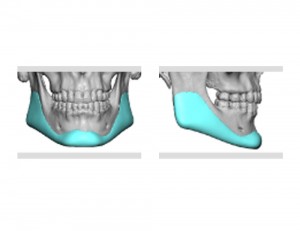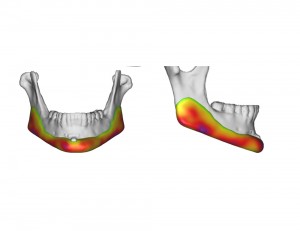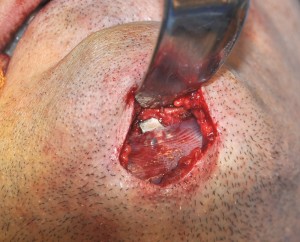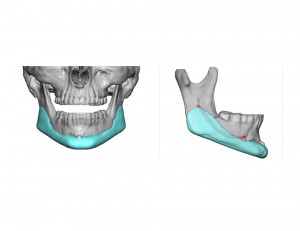Background: A prominent and more defined jawline is a facial feature that has always been in vogue for men and more recently that of women as well. While there are differences between jawline augmentation methods and objectives for man and women, a smooth jawline from front to back is characteristic of both of them.

With the emergence of custom jawline augmentation, I have run into a whole host of patients who have had prior surgeries with various forms of implants and other materials placed along their jawline. These include previous sliding genioplasties, silicone and Medpor implants, titanium plates and screws and hydroxyapatite blocks and granules. While in days gone by some of these would have been a surprise, 3D CT scans can pick up what is there and the implants can be designed with their virtual removal or made to fit around them.
Case Study: This 52 year-old male wanted a stronger jawline and had made prior surgical attempts to achieve it. He ha d a prior procedure that included a sliding genioplasty and the placement of a large amount of hydroxyapatite (HA) granules from the chin back to the jaw angles. While this provided some benefit to the chin, it had little success in making a stronger and more defined jawline.



Despite prior jaw surgery and implants, a custom jawline implant for augmentation can still be done. A 3D CT scan to make the implant helps identify potential jaw issues and materials. If needed the 3D CT planning can ‘remove’ what will serve as an obstruction and adjust for those bone surfaces changes in the custom jawline implant’s design.
Case Highlights:
1) Custom designed implants are the most effective method for complete jawline augmentation.
2) Prior mandibular surgery and jaw implants do not prohibit or prevent the design and placement of a total jawline implant.
3) 3D CT assessment and designing of jaw implants is essential for an optimal result in the face of altered mandibular anatomy.
Dr. Barry Eppley
Indianapolis, Indiana



